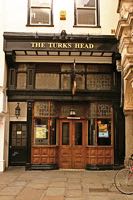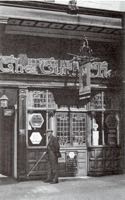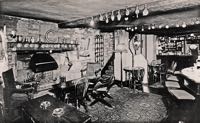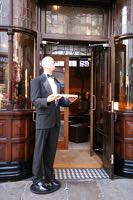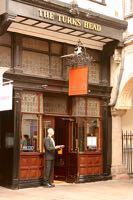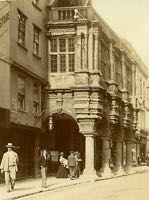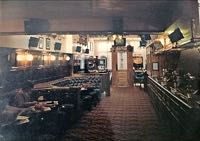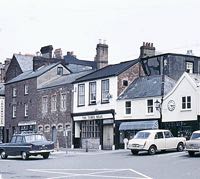
Turks Head - High Street
Page updated 15th June 2018
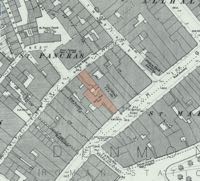 There has been
a tavern
on this site for more than
700 years. In 1289, the City Authorities granted to the owners of the
land the right to lean a beam against the wall of the Guildhall for the
sum of one penny per year. By the time of Charles II, inflation meant
that a penny was not sufficient and the rent was increased to two
pennies per year, which is the amount payable today.
There has been
a tavern
on this site for more than
700 years. In 1289, the City Authorities granted to the owners of the
land the right to lean a beam against the wall of the Guildhall for the
sum of one penny per year. By the time of Charles II, inflation meant
that a penny was not sufficient and the rent was increased to two
pennies per year, which is the amount payable today.
In 1569, the Turks Head Tavern was put up for sale and sold for
four
score pounds (£80) while the yearly rental for the site was
assessed at £4 10 shillings with a further sum of 10 shillings to
be paid to Her Sovereign Lady Queen Elizabeth. Documents confirming the
above are held by the museum. The inn has a very narrow frontage (13
ft) but is 130 ft deep and five stories high.
According to notes by Richard Pring, the rear was purchased in 1812 as the 'Inn in Waterbeer Street', while St Anne's Well brewery purchased rear in March 1899, as the Guildhall Vaults.
The origin of the name
There are several possibilities to the origin of the name. It is said that the name of the Turks Head refers to a Turkish prisoner who was held here when the inn was used as a prison. He met his end with the executioners axe. Wonder if he was called with the refrain 'time gentlemen please.... '. An alternative origin was suggested by Richard Pring of the City Brewery who wrote that there was a jousting ground at the rear of the establishment where a Saracens Head was used as a target, hence the name.
Elsewhere, the name probably goes back as far as the Crusades. It originally referred to members of the Tartars who settled in Turkey. Turks Head is also used to refer to a particular knot which is similar in shape to a turban, again indicating its link with the Crusades. The scourge of the 16th and 17th centuries, the Pirates of Algiers are said to have kidnapped into slavery people along the coast of Cornwall and were also connected with Turks Heads.
A Dicken's of a place
Charles Dickens used to sit in what is known as
Dicken's Corner. He
observed the character who became Fat Boy in Pickwick Papers. Dickens
was a frequent visitor to Exeter and he rented Mile End Cottage in
Alphington for his parents.
The fire
On 19 December 1874, at 3.30am, a fire broke out at the rear of the premises. The house dog started barking, waking the cook and a barmaid who roused the landlord Mr Hutchison, who evacuated to the Guildhall, his five children, who, shivering in their nightclothes were placed in front of the Guildhall's fireplace. Meanwhile, Inspector Wreford, stationed in the Guildhall, thought that the civic building may also be at risk, summoned the fire engines and sent police constables out to rouse the neighbours. The fire spread from a store room into a dining room, destroying a piano, pictures and furnishings. Just as the fire reached the bar at the front, the Sun engine arrived, and the flames were quickly brought under control. It is thought that this fire destroyed much of the original historic interior.
The premises were enlarged in 1899 when the Guildhall Vaults, adjacent to the Guildhall, on Waterbeer Street, and the Turks Head were joined. A cellar beneath this enlarged part of the premises were once part of the Guildhall cellar. A narrow alley, similar to Parliament Street, to the left of the facade, called Bussel Lane, ran between the High Street and Waterbeer Street–the door to the left is the old entrance. The original ground floor frontage was rebuilt in the early 20th Century, with the leaded windows and hip level oak panels. This was probably when five medieval fireplaces were found.
It closed in 2005 as the Turks Head bar, and reopened as the Prezzo chain Italian style restaurant. They removed the old Turks Head pub sign, and replaced it with a plasticky, ugly orange, 'Prezzo' sign, although the carved saracen's head can still be found above the entrance. This is no longer the ancient tavern with links to Charles Dickens, but a place that is no different to all the other food chain restaurants that are found in every High Street across the nation. Despite the degradation of the building over the years, it is still Grade II listed.
Some landlords listed in the trade directories are:
1816 - W Richards
1850 - J Sampson
1871 - William Kellaway
1874 - Samuel Hutchinson
1878 - Rowland Chown
1897 - William Henry Morton
1909 - William Henry Morton
1919 - John S Davey
1923 - Richard Blunden
1939 - Charles Henry Morton
1956 - G W Abell and N Hall
Sources: The British Newspaper Archive, Exeter Guidebooks.
│ Top of Page │
